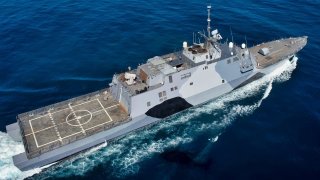China and Russia Have Big Plans for the Western Hemisphere
One of the most senior U.S. defense officials made clear that the Pentagon needs to adjust its strategy to maintain an advantage over China and Russia in the Western Hemisphere.
The end of the Global War on Terror ushered in an era of Great Power Competition between near-peer adversaries. When it comes to the defense priorities of the United States, al-Qaida and the so-called Islamic State have given way to the Chinese and Russian militaries.
This is a global competition—especially in the case of China—that isn’t limited to a specific geographic area of operations.
As competition with China and Russia increases, regions of the world that would otherwise be considered “quiet” are heating up. South America and the Caribbean are some of these “quiet” regions.
Countering China and Russia in America’s Backyard
One of the most senior U.S. defense officials made clear that the Pentagon needs to adjust its strategy to maintain an advantage over China and Russia in the Western Hemisphere.
“The Department of Defense clearly plays a very important role in terms of working with partner militaries in the region and enhancing defense cooperation and our ability to work together more seamlessly across multiple domains, including air, land, sea, space, and cyberspace,” Daniel P. Erikson, deputy assistant secretary of defense for the Western Hemisphere, said during an event at the Atlantic Council.
Titled “Countering China and Russia in Latin America and the Caribbean,” the event highlighted challenges posed by China and Russia in the Western Hemisphere.
“I also think that across U.S. industry, there really needs to be a deeper dive into what we can do to provide Latin American and Caribbean countries with the capabilities that they require at a price that they can afford,” the undersecretary of defense said.
Chinese activities in South America are broad and include technological infrastructure—for example, internet providers—that can be used to curtail U.S. defense and intelligence activities in the region. Beijing often enjoys a head start in infrastructural programs around the world because of its malicious behavior, which includes predatory loans and political coercion.
On the other hand, perhaps the biggest challenge the U.S. encounters in South America and the Caribbean—and Africa—is maintaining a balance between a need for alliances and partnerships with respecting American values such as human rights and democracy. The U.S. often has to interact with unsavory characters and regimes.
“We at DOD take very seriously the need for civilian control of the military, respect for human rights, and ensuring that militaries are abiding by the constitutional norms put forth by their democratic governments,” Erikson added.
For the most part, the Pentagon has seen South American militaries respect the norms of democratic governance, perhaps understanding that U.S. support is predicated on such a behavior.
“At the end of the day, the way that the United States can meet the challenge that's posed by great power competition in Latin America and the Caribbean is, really, by having a very proactive, affirmative and engaged U.S. agenda with the region and not just telling other countries what they shouldn't be doing with other partners, but what they can do with the United States,” Erikson stated.
About the Author
Stavros Atlamazoglou is a seasoned defense journalist specializing in special operations and a Hellenic Army veteran (national service with the 575th Marine Battalion and Army HQ). He holds a BA from Johns Hopkins University and an MA from the Johns Hopkins School of Advanced International Studies (SAIS). His work has been featured in Business Insider, Sandboxx, and SOFREP. Email the author: [email protected].


